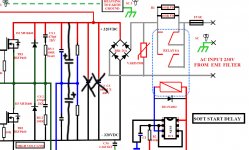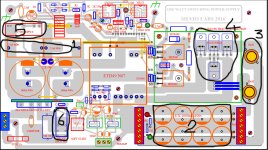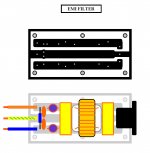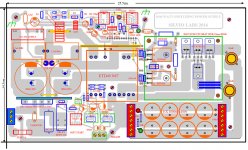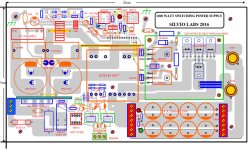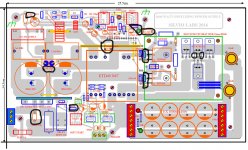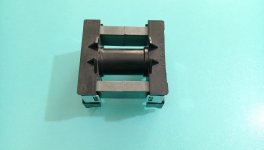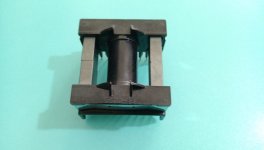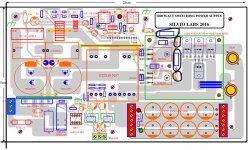You are using an out of date browser. It may not display this or other websites correctly.
You should upgrade or use an alternative browser.
You should upgrade or use an alternative browser.
1000w smps based on LUDO3232
- Thread starter Silvio
- Start date
Silvio
Well-known member
If you put a bigger core you get more power from it. The higher the frequency used the higher the power the core can give you, but there will also be more switching losses in the switching transistors and also in the output diodes.The more power you absorb the better the switching transistors have to be or you can parallel two or more mosfets for more power.
If you want to know more you better start reading some books about switching power supplies. You can read power supply cookbook from Marty brown for example.
Regards Silvio
If you want to know more you better start reading some books about switching power supplies. You can read power supply cookbook from Marty brown for example.
Regards Silvio
Silvio
Well-known member
hi mr silvio
in private message you said me you did not see my schematic pic
I meant from capacitor 680uf
in bottom pic
can i use 2*680uf 200v as follows
View attachment 6314
and what is number 5 piece in bottom pic?
View attachment 6315
and does has this smps overload and s/c protection?
respectfully
Input capacitors, You will need at least 1Uf per watt of load so for 1000 watts you will need 2 cap 470uf X 400v or 4 cap 1000uf X 200v. Using 2 X 680uf X 200v will be too small. When you hook up 2 caps in series the voltage rating will double but the capacitance is half. In your case you will have only 340uf X 400 volts
No 5 on the component schematic is a small switching supply providing 15vdc (aux supply)
Yes the smps has short circuit protection.
If you look for Ludo 3232 smps on this website it is more easy to build and you will find parts for it. I built my on what I had in my junk box.
Regards Silvio
Silvio
Well-known member
Oh alright that is the timing resistor and the capacitor near it. Practically both values of capacitor and resistor will give the same timing of around one second to latch the relay. If you observe closely one has 220k resistor and 2.2uf and the other has 100k resistor and double the capacitance 4.7uf.
Choose whatever you want.
Regards Silvio
Choose whatever you want.
Regards Silvio
Silvio
Well-known member
1) What is the peak (Maximum) voltage your amplifier can take?
2) What is your mains input voltage?
3) What is the core material of your trafo example ferrox cube 3C90, Epcos N27 or 87 etc
Answer me on the questions above and I will tell you what number of turns and wire gauge you need and also the sequence how to wind it
Regards Silvio
2) What is your mains input voltage?
3) What is the core material of your trafo example ferrox cube 3C90, Epcos N27 or 87 etc
Answer me on the questions above and I will tell you what number of turns and wire gauge you need and also the sequence how to wind it
Regards Silvio
Last edited:
Those are snubber components they work as frequency compensation, I believe it was stated in the pdf documentation. I do think the SMPS will work without them.
Silvio
Well-known member
Transformer winding sequence
Transformer calculations
frequency 60Khz B= 1400 guass input voltage 230v AC transformer ETD49
copper wire 0.5mm
Primary 22 turns Secondary 7 turns (7.2v per turn)
Peak output voltage 50.9 volts each rail at 230 volts
Output capacitance 4000 uf per rail (4 X 1000uf)
output inductor 1.5 uH per rail ( 5.5 turns enameled copper wire 1.5mm dia on 10mm ferrite rod 30mm long)
Maximum current at output 12A @ 84volts = 1000W
Copper wire primary:---5 wires 0.5mm twisted together (2.8 meters long) approx
copper wire secondary:---8 wires 0.5mm (2 bundles 4wires twisted together ) (3.5mts long) approx
Margin tape = 5mm on each side for primary and secondary
Winding sequence
make 5mm wide margin tape on each side of bobbin (about 2mm high)
1/2 primary 11 turns ( leave the extra wire on the side to wind the second half with it)
3 layers of Mylar tape (cover the whole width of the bobbin with tape)
Make 5mm margin tape on each side of bobbin
1/2 secondary 7 turns ( start from center tap and leave around 100mm of wire outside bobbin) put 2 bundles of 4 twisted wires side by side and wind together.
2 layers of mylar tape
make 5mm margin
1/2 secondary 7 turns ( same as above)
3 layers of mylar tape to cover whole width of bobbin
make 5mm margin tape
Half Primary Take the rest of the wire of the primary and wind the rest of the 11 turns.
3 layers of mylar tape
Auxiliary windings
calculate at 7volts per turn so for 21volts = 3turns and for 14volts = 2 turns,
If you want a double winding then put 2 wires 0.5mm together and start from center tap and wind the turns needed then put the ends on each pin.
3 layers of Mylar tape
IMPORTANT Please follow the instructions carefully and use suitable tapes suggested for a safe transformer
You have to put sleeving at the ends of each wire.
Take a look at the video on youtube and follow the instructions there The video is called winding small transformers for smps (By Silvio) you will take good advice how to wind a good transformer.
Regards Silvio
![IMG_0780[1].JPG IMG_0780[1].JPG](https://www.diysmps.com/forums/data/attachments/5/5312-0cb0a6b7040f1ea11716717662da3e55.jpg)
![IMG_0781[1].JPG IMG_0781[1].JPG](https://www.diysmps.com/forums/data/attachments/5/5313-c8f73d223eab95fc26b3961f91be2215.jpg)
![IMG_0783[1].JPG IMG_0783[1].JPG](https://www.diysmps.com/forums/data/attachments/5/5314-26dc858b931057de2f9a95dc4c275394.jpg)
Transformer calculations
frequency 60Khz B= 1400 guass input voltage 230v AC transformer ETD49
copper wire 0.5mm
Primary 22 turns Secondary 7 turns (7.2v per turn)
Peak output voltage 50.9 volts each rail at 230 volts
Output capacitance 4000 uf per rail (4 X 1000uf)
output inductor 1.5 uH per rail ( 5.5 turns enameled copper wire 1.5mm dia on 10mm ferrite rod 30mm long)
Maximum current at output 12A @ 84volts = 1000W
Copper wire primary:---5 wires 0.5mm twisted together (2.8 meters long) approx
copper wire secondary:---8 wires 0.5mm (2 bundles 4wires twisted together ) (3.5mts long) approx
Margin tape = 5mm on each side for primary and secondary
Winding sequence
make 5mm wide margin tape on each side of bobbin (about 2mm high)
1/2 primary 11 turns ( leave the extra wire on the side to wind the second half with it)
3 layers of Mylar tape (cover the whole width of the bobbin with tape)
Make 5mm margin tape on each side of bobbin
1/2 secondary 7 turns ( start from center tap and leave around 100mm of wire outside bobbin) put 2 bundles of 4 twisted wires side by side and wind together.
2 layers of mylar tape
make 5mm margin
1/2 secondary 7 turns ( same as above)
3 layers of mylar tape to cover whole width of bobbin
make 5mm margin tape
Half Primary Take the rest of the wire of the primary and wind the rest of the 11 turns.
3 layers of mylar tape
Auxiliary windings
calculate at 7volts per turn so for 21volts = 3turns and for 14volts = 2 turns,
If you want a double winding then put 2 wires 0.5mm together and start from center tap and wind the turns needed then put the ends on each pin.
3 layers of Mylar tape
IMPORTANT Please follow the instructions carefully and use suitable tapes suggested for a safe transformer
You have to put sleeving at the ends of each wire.
Take a look at the video on youtube and follow the instructions there The video is called winding small transformers for smps (By Silvio) you will take good advice how to wind a good transformer.
Regards Silvio
![IMG_0780[1].JPG IMG_0780[1].JPG](https://www.diysmps.com/forums/data/attachments/5/5312-0cb0a6b7040f1ea11716717662da3e55.jpg)
![IMG_0781[1].JPG IMG_0781[1].JPG](https://www.diysmps.com/forums/data/attachments/5/5313-c8f73d223eab95fc26b3961f91be2215.jpg)
![IMG_0783[1].JPG IMG_0783[1].JPG](https://www.diysmps.com/forums/data/attachments/5/5314-26dc858b931057de2f9a95dc4c275394.jpg)
Silvio
Well-known member
@ Behrad
Please make a small correction to the data above.
wire for primary is to be 2 bundles 0.5mm X 3 wires (2 bundles of 3 wires each twisted) 6 wires in all
Margin width is to be 3mm on each side
This will be better for current handling in the primary winding. Also 3 wires place themselves better when twisted together
Regards, Silvio
Please make a small correction to the data above.
wire for primary is to be 2 bundles 0.5mm X 3 wires (2 bundles of 3 wires each twisted) 6 wires in all
Margin width is to be 3mm on each side
This will be better for current handling in the primary winding. Also 3 wires place themselves better when twisted together
Regards, Silvio

